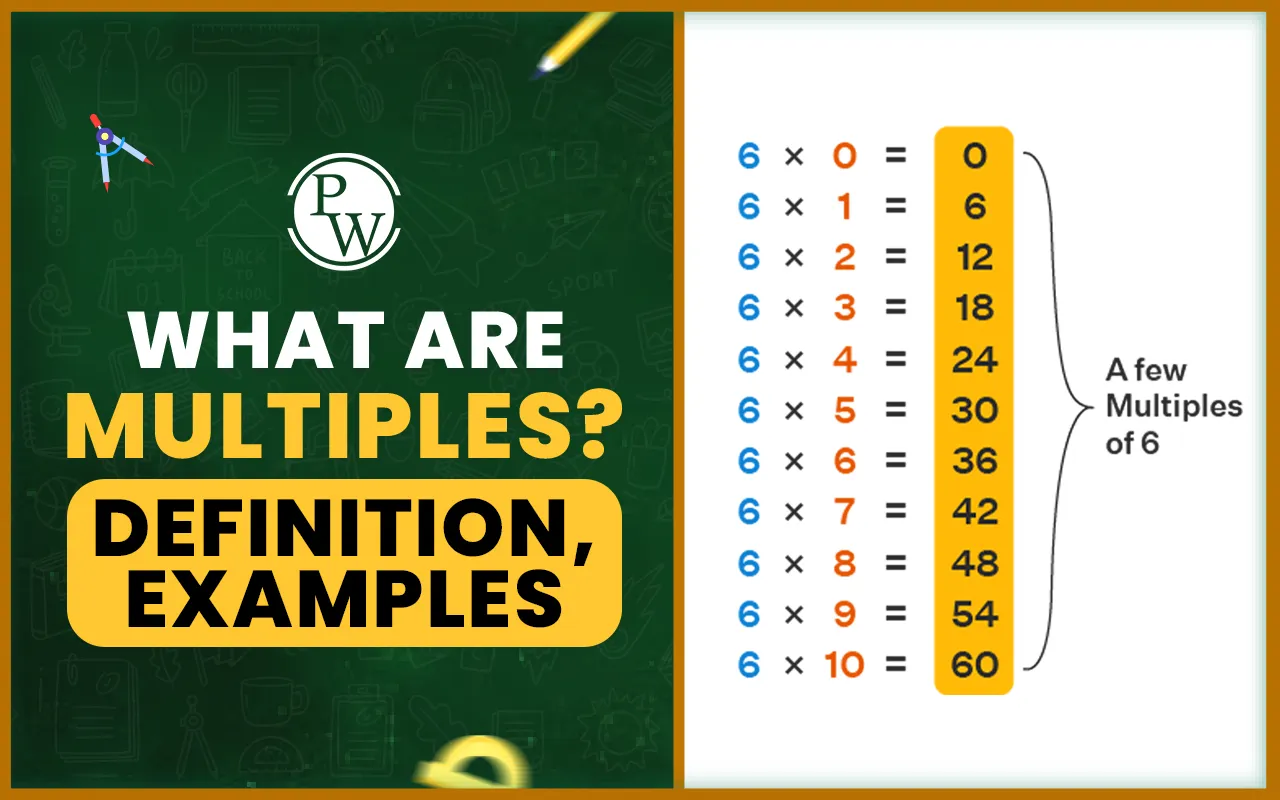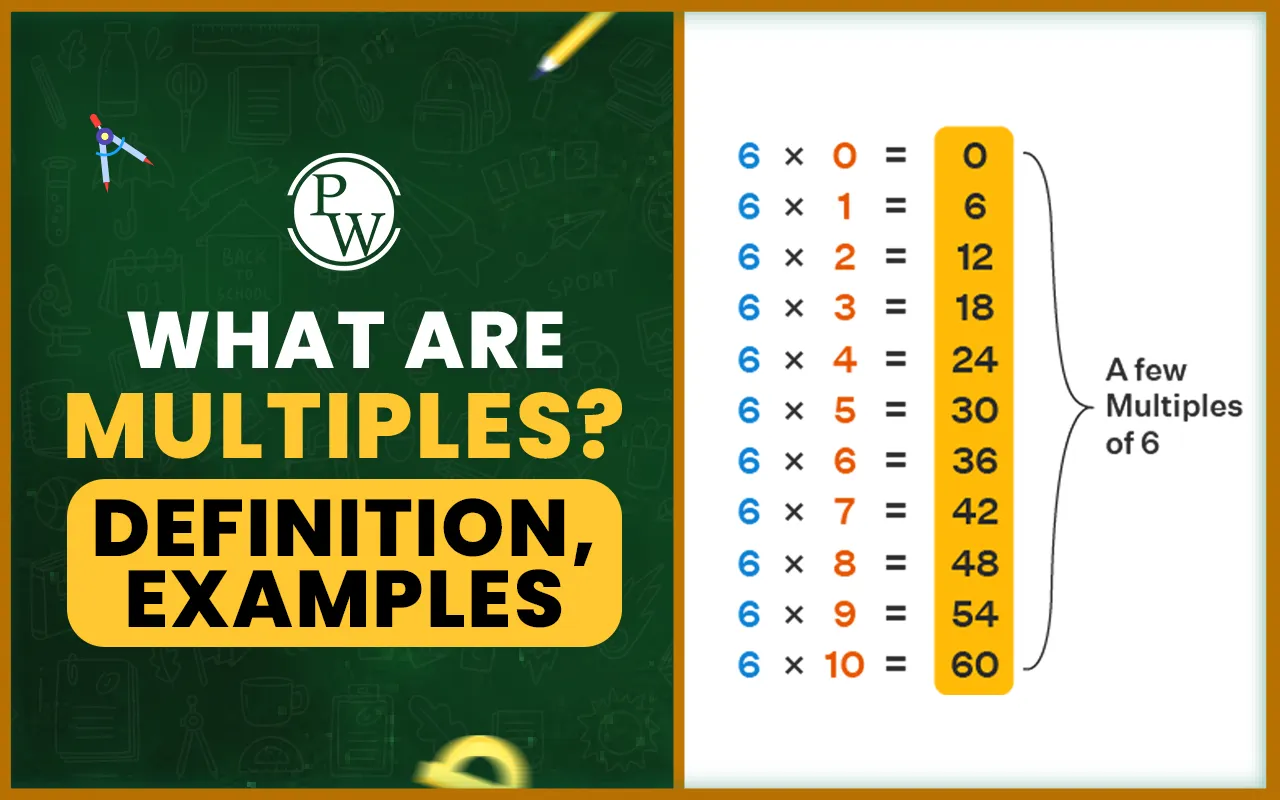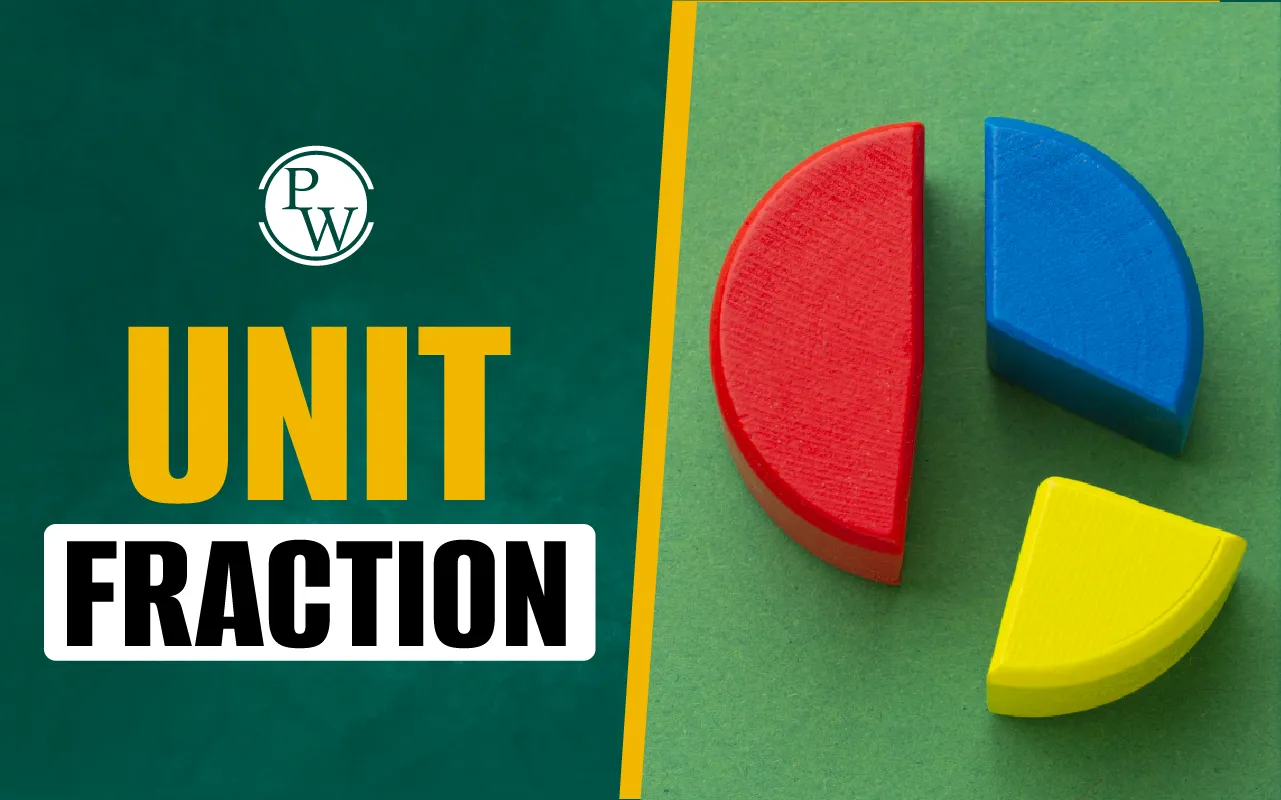

An interesting math concept is multiples, which relate numbers to each other. As you add a number repeatedly to itself, you get its multiples. The basis of any math calculation is the multiplication table, which lists all multiples of a given number.
Beyond mathematics, multiples help us calculate costs, organize items evenly, and even solve puzzles. This blog explains the multiple meanings in math, how to identify them, and provides plenty of examples to make math learning simple and fun.
Read More: Multiple of Fractions
What is a Multiple?
A multiple of a number is the number obtained by multiplying that number by another whole number. It means when you multiply a number by any other number, such as 1, 2, 3, 4, etc., the values you get are called multiples of that number. For example, if we multiply 6 by 1, 2, 3, 4, and 5, we get the values 6, 12, 18, 24, and 30. Therefore, multiples of 6 are 6, 12, 18, 24, and 30.
Multiplication Means Repeated Addition
As per the definition of multiple, when we multiply a number by another number to get its multiple, we add the same number repeatedly a number of times by which it is being multiplied.
For example, when we multiply 3 by 5, we add 3 repeatedly 5 times. In other words, 3 x 5 = 3 + 3 + 3 + 3 + 3 = 15.
How Multiples Work in Math?
The idea of multiples in math is a fundamental concept applicable to different types of problem-solving. Let’s explain how it works:
Suppose we take the number 4 and multiply it by different whole numbers, starting from 1. The results are as follows:
-
4 × 1 = 4
-
4 × 2 = 8
-
4 × 3 = 12
-
4 × 4 = 16
-
4 × 5 = 20…and so on.
So, we can say that the numbers 4, 8, 12, 16, 20… are the multiples of 4.
Read More: Division of Fractions
Multiple Tables
A table of multiples is a simple table containing the list of multiples of a number. It is a ready reference for students to learn and apply mathematical problem-solving quickly and accurately. The multiplication table of some numbers is given below.
|
Multiple Tables |
||
|
Table of 3 |
Table of 8 |
Table of 10 |
|
3 x 1 = 3 |
8 x 1 = 8 |
10 x 1 = 10 |
|
3 x 2 = 6 |
8 x 2 = 16 |
10 x 2 = 20 |
|
3 x 3 = 9 |
8 x 3 = 24 |
10 x 3 = 30 |
|
3 x 4 = 12 |
8 x 4 = 32 |
10 x 4 = 40 |
|
3 x 5 = 15 |
8 x 5 = 40 |
10 x 5 = 50 |
|
3 x 6 = 18 |
8 x 6 = 48 |
10 x 6 = 60 |
|
3 x 7 = 21 |
8 x 7 = 56 |
10 x 7 = 70 |
|
3 x 8 = 24 |
8 x 8 = 64 |
10 x 8 = 80 |
|
3 x 9 = 27 |
8 x 9 = 72 |
10 x 9 = 90 |
|
3 x 10 = 30 |
8 x 10 = 80 |
10 x 10 = 100 |
Key Characteristics of Multiples
The properties of multiples help you understand the concept of multiples clearly and easily. Here are the main characteristics of multiples:
-
The multiple of any number is the number itself. For example, 9 is a multiple of 9 because 9 x 1 = 9.
-
Multiples of a number continue infinitely in the ascending order because a number can be multiplied by an infinite number.
-
Multiple of a number is either equal to or greater than the number. For example, 2, 4, 6, 8… are multiples of 2. Here, the first multiple of 2 is equal to the given number, and all other multiples are greater than 2.
Read More: Prime Factorization Method
Multiples on the Number Line
Multiples of a number can be represented easily on a number line. Starting from that number, if we continue to skip the places equal to the number, we get all the multiples of that number by skipping counting.
For example, to find the multiples of 5, we start from 0 and continue skipping five places, which gives us the values 5, 10, 15, 20, and so on as different multiples of 5.
Difference Between Multiple and Factor
Many students get confused between multiples and factors. Multiples are numbers that can be divided by the original number without leaving a remainder.
For example, 21 is a multiple of 3 and 7 because it can be divided by 3 and 7 without leaving a remainder. Here, 3 and 7 are called the factors of 21. The difference between multiple and factor is given below.
|
Difference Between Multiple and Factor |
||
|
Feature |
Multiple |
Factor |
|
Definition |
Product of a given number and a whole number |
A number that divides a given number without leaving a remainder |
|
Example |
2 x 3 × 7 = 42. Here, 42 is a multiple of 2, 3, and 7 |
3 is a factor of 42 because 42 ÷ 3 = 14 |
|
Value Increasing or Decreasing |
Increases by the given number with each multiple |
Smaller than or equal to the given number |
|
Infinite or Finite |
Multiples can be infinite in number |
The number of factors is finite |
Read More: Improper Fractions
What is the Least Common Multiple (LCM)?
The least common multiple (LCM) of two or more numbers is the smallest common multiple among all the given numbers.
For example, we take the numbers 3, 4, and 6.
-
Multiples of 3 are 3, 6, 12, 15, 18, 21, 24...
-
Multiples of 4 are 4, 8, 12, 16, 20, 24...
-
Multiples of 6 are 6, 12, 18, 24, 30, 36…
So, the common multiples of these three numbers are 12 and 24.
Here, the lowest common multiple of the given numbers is 12.
So, 12 is the LCM of 3, 4, and 6.
Multiple Solved Examples
1. Find the first 6 multiples of 5.
Solution: The first 6 multiples of 5 are calculated as follows:
5 x 1 = 5
5 x 2 = 10
5 x 3 = 15
5 x 4 = 20
5 x 5 = 25
5 x 6 = 30
Ans. The first 6 multiples of 5 are 5, 10, 15, 20, 25, and 30.
2. Is 35 a multiple of 7?
Solution: From the table of 7, we get 7 × 5 = 35
So, we can say that 35 is a multiple of 7.
3. Is 28 a multiple of 8?
Solution: From the table of 8, we get:
8 × 3 = 24 and 8 × 4 =32
The number 28 lies between 24 and 32, but no whole number can be multiplied by 8 to get 24.
So, 28 is not a multiple of 8.
4. Find the missing numbers in the given series: 7, 14, 21, __, 35, 42, __, 56, __
Solution: In the given series, we can see that
7 x 1= 7
7 x 2 = 14
7 x 3 = 21
So, the numbers increase as multiples of 7.
Therefore, the next number after 21 will be: 7 x 4 = 28
Again, the number after 42 (7 x 6) will be: 7 x 7 = 49 and the number after 56 (7 x 8) will be 7 x 9 = 63
5. Find the LCM of 6, 8, and 12
Solution:
Multiples of 6 are: 6, 12, 18, 24, 30…
Multiples of 8 are: 8, 16, 24, 32, 40…
Multiples of 12 are: 12, 24, 36, 48, 60…
Therefore, the Lowest Common Multiple (LCM ) of 6, 8, and 12 is 24.
Also read: Find the Sum
Understanding what a multiple is is one of the basic concepts of mathematics. From simple multiplication to complex problem-solving, multiples in math play a major role in helping students master arithmetic and number patterns.
Improve Your Child’s Math Skills With CuriousJr Mental Math Classes
It’s a common concern for many parents to observe their child struggling with slow math calculations, poor accuracy, or confusion over basic concepts. These issues frustrate students and eventually affect their confidence and academic performance.
Curious Junior’s Mental Maths Classes are specially designed to address these challenges and help kids build a solid foundation in math through fun, structured, and student-friendly techniques.
Key Benefits for Students:
-
Over 50 engaging mental math calculation tricks to solve problems quickly without depending on calculators or fingers.
-
Personalized learning approach by assessing each child’s strengths and weaknesses and providing necessary support and guidance.
-
Visual, interactive, and logical learning tools help children grasp concepts and make complex problems easier to understand and solve.
-
One-on-one attention and doubt-clearing support by dedicated mentors.
-
With real-time feedback, parents and students can track performance improvements and identify focus areas.
CuriousJr’s mental math classes help students take a logical approach to handle math problems, which improves speed and accuracy. Book a demo class today and watch your child solve complex math problems easily and confidently.
Multiples FAQs
What is the smallest multiple of any number?
Can multiples be negative?
What are even and odd multiples?
What does the square of a number signify?













